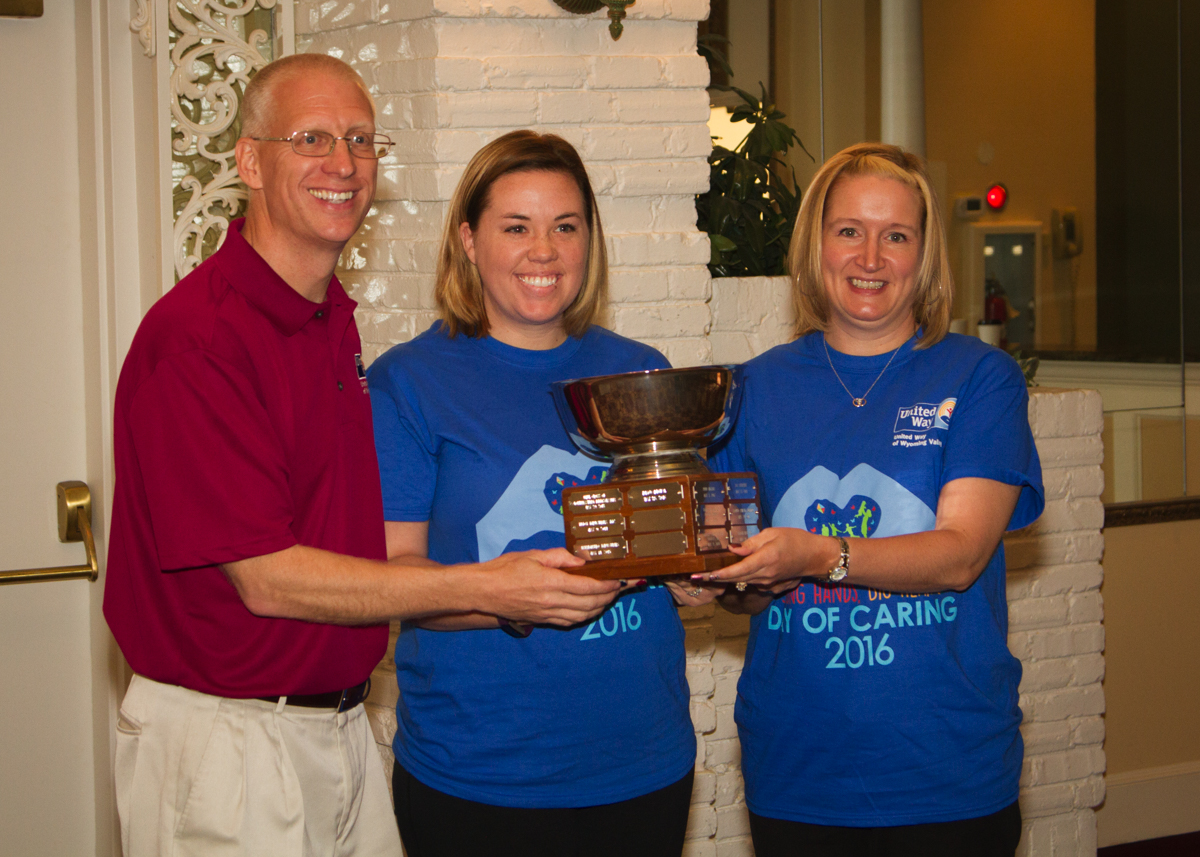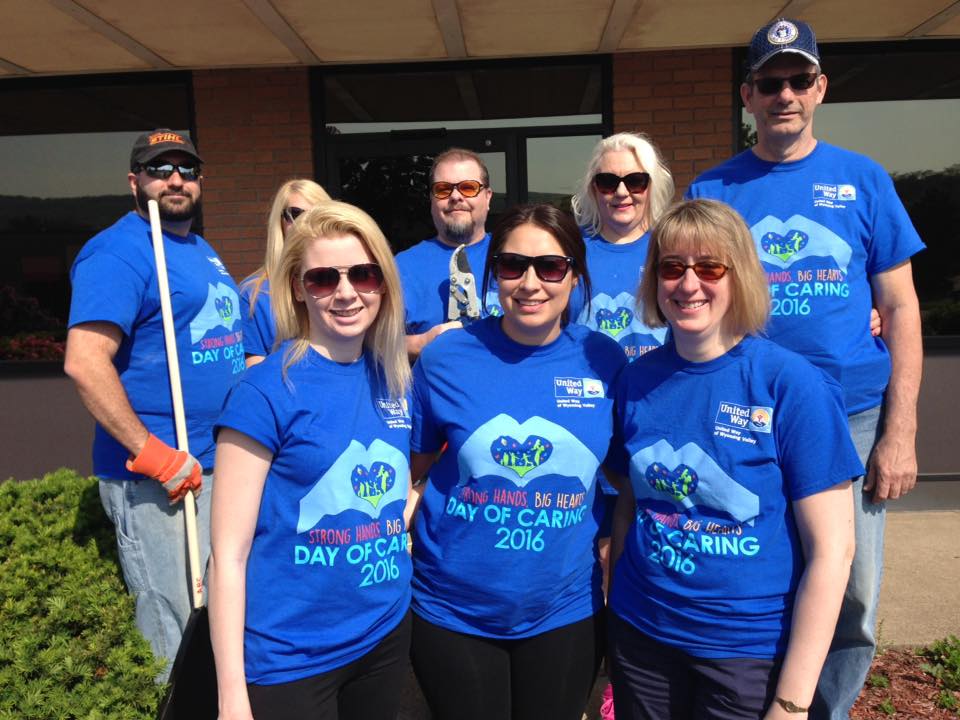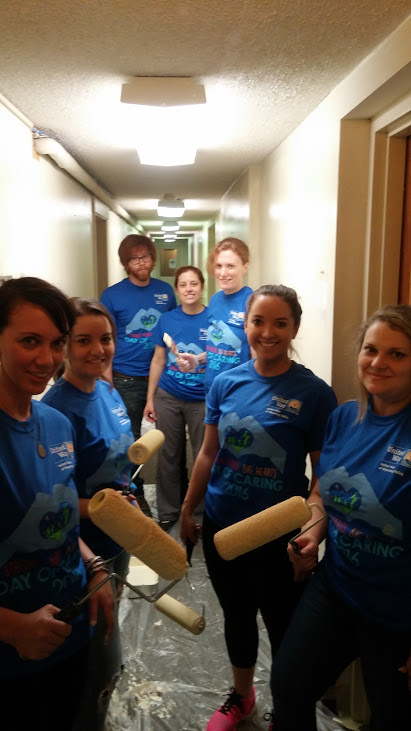Nonprofit bestows prestigious ‘100+ Employee Corporate Award’ on distributor; 39 associates volunteer during annual ‘Day of Caring’
Putting words into action. Volunteers at the United Way of Wyoming Valley Day of Caring who donated 470 volumes to support ongoing children’s book drive literally did just that.
The United Way of Wyoming Valley requested in advance that all attendees of its annual Day of Caring opening breakfast, May 25, bring a new or gently used children’s book to benefit the youngest members of the population in the Wyoming Valley and their families.
For more than 21 years, the United Way of Wyoming Valley has sponsored an annual Day of Caring. Each year, hundreds of representatives of business, industry, education and healthcare come together as volunteers, roll up their sleeves, and set to work helping nonprofit and charitable organizations throughout the Wyoming Valley area of Northeastern Pennsylvania with projects that their limited budgets can't cover.
Since 2009, Benco Dental has invited associates of the company to participate in Day of Caring during their workday. At the event's 2016 opening breakfast, May 25, members of the Benco Dental family joined nearly 700 volunteers at Best Western Genetti Hotel & Conference Center in downtown Wilkes-Barre, Pennsylvania, where Bill Jones, United Way of Wyoming Valley CEO, shared the organization’s goal of reducing childhood poverty.
The organization’s executive director addressed the group he described as “a sea of blue with strong hands and big hearts” (participants received blue T-shirts bearing the slogan: “Strong Hands. Big Hearts. Day of Caring 2016”) regarding the opportunities that awaited them in the community. In his discussion he referenced an African proverb “If you want to go fast, go alone. If you want to go far, go together,” when he reminded those in attendance: “Together we are helping more children and families achieve better health and outcomes.”
During the breakfast program, organizations were recognized for their support of the United Way’s 2015-2016 Community Campaign, Benco Dental among them, as recipient of the prestigious United Way of Wyoming Valley Corporate Award (100+ employees). Accepting for the nation’s largest privately owned dental distributor, Benco Dental, were Becky Clouse-Mickey, Talent Manager, and Michelle Kovaleski, Culture and People Coordinator.
“This year’s first corporate award goes to an organization that is a true United Way partner – Benco Dental. They exemplify all of the qualities we could hope for in an organization on a year-round basis. With every year that passes, they continue to astound us with the support they provide in campaigns, special events, and volunteerism,” said Don Brominski, who with his wife Rebecca Brominski, served as United Way Annual Campaign Co-Chair.
“Generously, Benco Dental and its employees have contributed almost $900,000 over the past 13 years. Benco Dental also provides a corporate match on employee gifts and is ranked within the Top 10 companies for largest employee campaign, corporate gifts, and number of leadership gifts. Benco’s commitment to supporting United Way doesn’t end when the campaign is over: the company has been a long-standing supporter of our Christmas in July Food Drive, and as we can see this morning, an enthusiastic participant in the annual Day of Caring,” explained Brominski, during the award presentation. “Special thanks to the Cohen Family and all of the employees of Benco Dental for being such great partners over the years.”
Upon hearing news of the award, George Rable, Vice President, Culture and People for Benco Dental, expressed the sentiment shared among the members of the Benco family.
“The Benco Team is very honored to receive this recognition from the United Way of Wyoming Valley. Our associates are generous both with their time and in making financial pledges to help improve the lives of our neighbors,” said Rable.
In a record-setting volunteer turnout for United Way of Wyoming Valley’s Day of Caring on May 25, more than 949 volunteers from 68 organizations completed 56 community projects at 41 local agencies, according to Jones. Those volunteers were supported by an additional 200+ volunteers who did preparation work for Day of Caring projects. Those volunteers included local school students who created items for children’s preschool literacy kits, and assembled hygiene kits for distribution to organizations that help the homeless. When all Day of Caring efforts are combined, a total 1,168 volunteers contributed 5,845 volunteer hours with an estimated value of $137,708, Jones added.
According to Benco Dental Talent Specialist Florence Marchesano, 39 Benco Dental associates took part in the Day of Caring efforts. Their day included:
* painting and drywall repair at Family Service Association of NEPA in Wilkes-Barre, which provides diverse services to children, individuals, seniors, and families, empowers them to achieve their full potential and results in healthier relationships and stronger communities,
* property beautification, organization and cleanup of disaster services equipment at Red Cross of Northeast Pennsylvania, which serves 600,000 people in four counties, helping residents recover from disasters like fires and floods, providing life-saving training in first aid and CPR and collecting blood donations for the entire region.
* cleaning, gardening and painting at SPCA of Luzerne County, which offers a variety of programs and services designed to help both people and animals and strives to create solutions to many of the animal-related issues facing our community, and
* cleaning at the West Pittston Library, which enriches the lives of community members by creating an environment for growth, discovery and connection.
For details about the United Way of Wyoming Valley Day of Caring or to support its efforts, visit: https://www.unitedwaywb.org/day-of-caring.html.
To learn more about Family Service Association of NEPA, visit: https://www.fsawv.org/, Red Cross of Northeast Pennsylvania, visit: https://www.redcross.org , SPCA of Luzerne County, visit: https://www.spcaluzernecounty.org/ and West Pittston Library, visit: https://www.wplibrary.org/
 During the May 25 United Way Day of Caring breakfast program at Best Western Genetti Hotel & Conference Center in Wilkes-Barre, Pennsylvania, more than 700 gathered to prepare for a day of volunteerism. At the breakfast, organizations were recognized for their support of the United Way’s 2015-2016 Community Campaign, Benco Dental among them. The nation’s largest privately owned dental distributor was recognized with the prestigious United Way of Wyoming Valley Corporate Award (100+ employees). Shown, accepting the award from United Way of Wyoming Valley CEOBill Jones, are Becky Clouse-Mickey and Michelle Kovaleski, representing Benco Dental.
During the May 25 United Way Day of Caring breakfast program at Best Western Genetti Hotel & Conference Center in Wilkes-Barre, Pennsylvania, more than 700 gathered to prepare for a day of volunteerism. At the breakfast, organizations were recognized for their support of the United Way’s 2015-2016 Community Campaign, Benco Dental among them. The nation’s largest privately owned dental distributor was recognized with the prestigious United Way of Wyoming Valley Corporate Award (100+ employees). Shown, accepting the award from United Way of Wyoming Valley CEOBill Jones, are Becky Clouse-Mickey and Michelle Kovaleski, representing Benco Dental.
 Benco Dental associates participated in the May 25 United Way Day of Caring, during which representatives of business, industry, education and healthcare come together as volunteers to help nonprofit and charitable organizations throughout the Wyoming Valley area of Northeastern Pennsylvania. Benco Dental associates are shown volunteering at the West Pittston Library: first row, from left, Donna Lasota, Ashley DeFlice, second row: Ryan Alunni, Mandy Welman, Mary Gregor, third row: Jim Soroka, Ken Lee, Kathy Jesso, and Becky Clouse-Mickey.
Benco Dental associates participated in the May 25 United Way Day of Caring, during which representatives of business, industry, education and healthcare come together as volunteers to help nonprofit and charitable organizations throughout the Wyoming Valley area of Northeastern Pennsylvania. Benco Dental associates are shown volunteering at the West Pittston Library: first row, from left, Donna Lasota, Ashley DeFlice, second row: Ryan Alunni, Mandy Welman, Mary Gregor, third row: Jim Soroka, Ken Lee, Kathy Jesso, and Becky Clouse-Mickey.
 Thirty-nine Benco Dental associates participated in the May 25 United Way Day of Caring, during which representatives of business, industry, education and healthcare come together as volunteers to help nonprofit and charitable organizations throughout the Wyoming Valley area of Northeastern Pennsylvania. . Benco Dental associates are shown volunteering with employees from Pride Mobility at the Red Cross of Northeast Pennsylvania: Cassandra George, Valerie Sanchez, Stacy Wardle, Geoff Fontenova, Bill Emmett, and Calvin Strohl.
Thirty-nine Benco Dental associates participated in the May 25 United Way Day of Caring, during which representatives of business, industry, education and healthcare come together as volunteers to help nonprofit and charitable organizations throughout the Wyoming Valley area of Northeastern Pennsylvania. . Benco Dental associates are shown volunteering with employees from Pride Mobility at the Red Cross of Northeast Pennsylvania: Cassandra George, Valerie Sanchez, Stacy Wardle, Geoff Fontenova, Bill Emmett, and Calvin Strohl.

Thirty-nine Benco Dental associates participated in the May 25 United Way Day of Caring, during which representatives of business, industry, education and healthcare come together as volunteers to help nonprofit and charitable organizations throughout the Wyoming Valley area of Northeastern Pennsylvania. Benco Dental associates are shown volunteering at Family Service Association: clockwise, from left, Rachel Pugh, Loriah Webby, Eric Larsen, Jennifer Ochman, Kelly Hilsey, Keely Brazil, and Kristie Ceruti.












 Benco Dental associates participated in the May 25 United Way Day of Caring, during which representatives of business, industry, education and healthcare come together as volunteers to help nonprofit and charitable organizations throughout the Wyoming Valley area of Northeastern Pennsylvania. Benco Dental associates are shown volunteering at the West Pittston Library: first row, from left, Donna Lasota, Ashley DeFlice, second row: Ryan Alunni, Mandy Welman, Mary Gregor, third row: Jim Soroka, Ken Lee, Kathy Jesso, and Becky Clouse-Mickey.
Benco Dental associates participated in the May 25 United Way Day of Caring, during which representatives of business, industry, education and healthcare come together as volunteers to help nonprofit and charitable organizations throughout the Wyoming Valley area of Northeastern Pennsylvania. Benco Dental associates are shown volunteering at the West Pittston Library: first row, from left, Donna Lasota, Ashley DeFlice, second row: Ryan Alunni, Mandy Welman, Mary Gregor, third row: Jim Soroka, Ken Lee, Kathy Jesso, and Becky Clouse-Mickey. Thirty-nine Benco Dental associates participated in the May 25 United Way Day of Caring, during which representatives of business, industry, education and healthcare come together as volunteers to help nonprofit and charitable organizations throughout the Wyoming Valley area of Northeastern Pennsylvania. . Benco Dental associates are shown volunteering with employees from Pride Mobility at the Red Cross of Northeast Pennsylvania: Cassandra George, Valerie Sanchez, Stacy Wardle, Geoff Fontenova, Bill Emmett, and Calvin Strohl.
Thirty-nine Benco Dental associates participated in the May 25 United Way Day of Caring, during which representatives of business, industry, education and healthcare come together as volunteers to help nonprofit and charitable organizations throughout the Wyoming Valley area of Northeastern Pennsylvania. . Benco Dental associates are shown volunteering with employees from Pride Mobility at the Red Cross of Northeast Pennsylvania: Cassandra George, Valerie Sanchez, Stacy Wardle, Geoff Fontenova, Bill Emmett, and Calvin Strohl.


